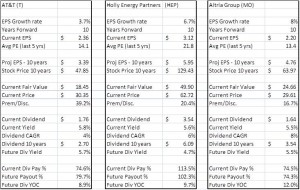My model for performing the intrinsic and future values are shown in the table below using three stocks that are trading at a premium or discount
to their fair value. By using the average PE ratio and projected EPS growth, you can use the future time value formula to get an estimate of earnings X number of years into the future. Once you have the future projected earnings per share, just multiply by the PE ratio to get a future stock price. All of the projected growth rates are available on most websites providing detailed stock information. This is great information when looking at the future of a stock in comparative terms. Take this one step further, and you can determine the intrinsic value of a stock. Here, you are using the present time value formula based on your required rate of return. The end result is having a fair value estimate of the stock to compare to the stock’s current trading price. This comparison will determine if a stock is overvalued or trading at a discount.
We use the same concept to determine the future dividend payout and yield in future years. For me, I prefer to project 10 years forward based on past compound annual growth rates [CAPG] of 10 years of data. The number of years can be adjusted for shorter time periods for stocks with less than 10 years of public data. What should your required rate of return be? I am currently using a 10% return on invested capital. Here is my assessment of three high yield
stocks.
Altria Group (MO) engages in the manufacture and sale of cigarettes, smokeless products, and wine in the United States and internationally. Currently, MO is trading at a 17% premium to its fair value. It has an EPS growth rate of 8%, with an average PE of 13.4. MO is projected to have a future dividend yield
of 5.5%, but its dividend yield on cost is projected to be 12% in 10 years. This is an excellent investment to buy as a dividend grower especially on a pullback to its fair value of $25.
AT&T Inc., (T) provides telecommunication services to consumers, businesses, and other service providers worldwide. Currently, T is trading at a 39% premium to its fair value. It has an EPS growth rate of 3.7%, with an average PE of 14. T is projected to have a future dividend yield of 5.7%, but its dividend yield on cost is projected to be 8.9% in 10 years. AT&T is overpriced for such a low growing stock but is a stable dividend payer.
Holly Energy Partners, L.P. (HEP) operates a system of petroleum product and crude oil pipelines, storage tanks, distribution terminals, and loading rack facilities. HEP is trading at a 20% premium to its fair value. It has an EPS growth rate of 6.7%, with an average PE of 21. HEP is projected to have a future dividend yield of 4.7%, but its dividend yield on cost is projected to be 9.7% in 10 years. Investors should be cautious as HEP has a payout over 100% of EPS.

